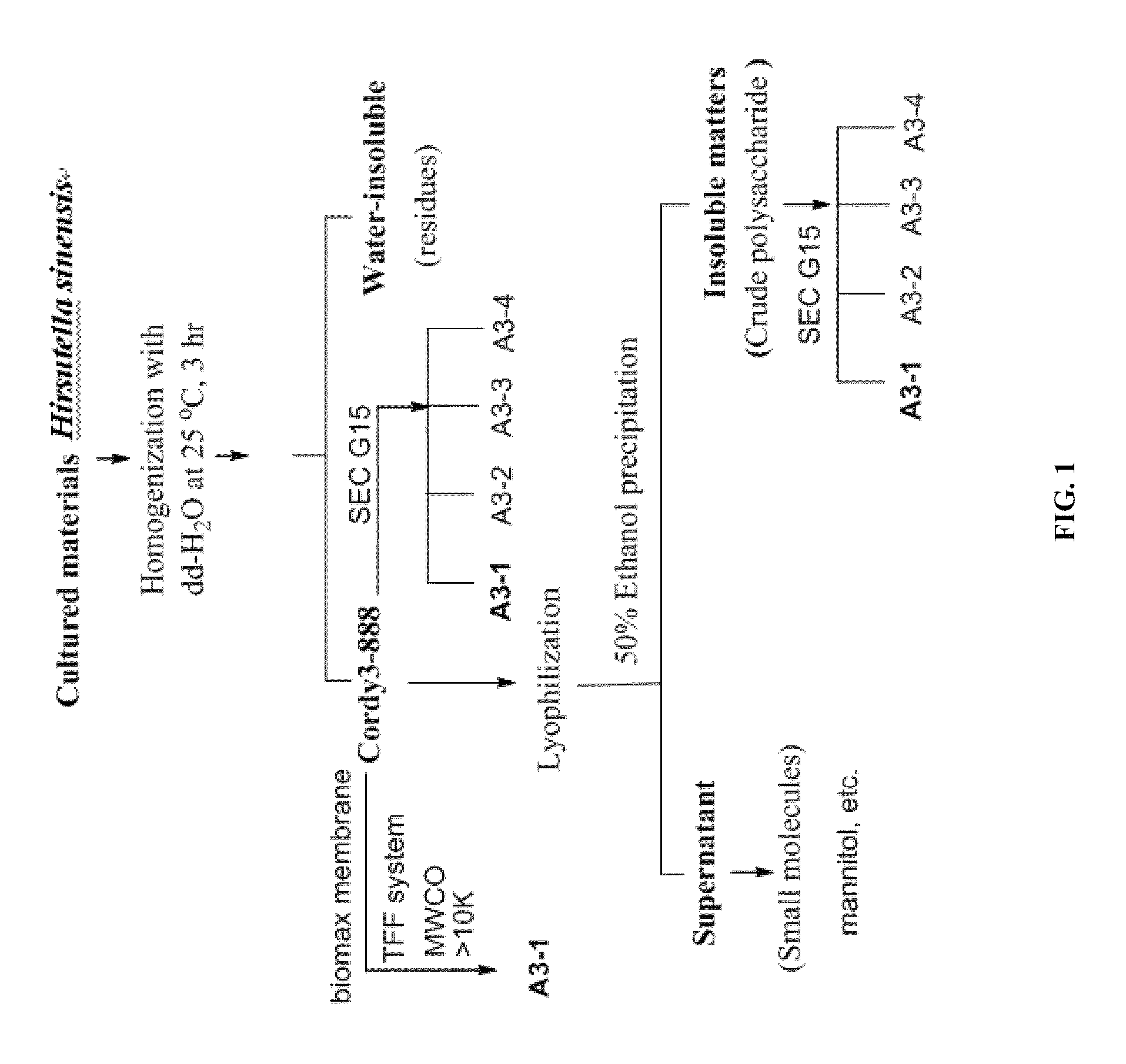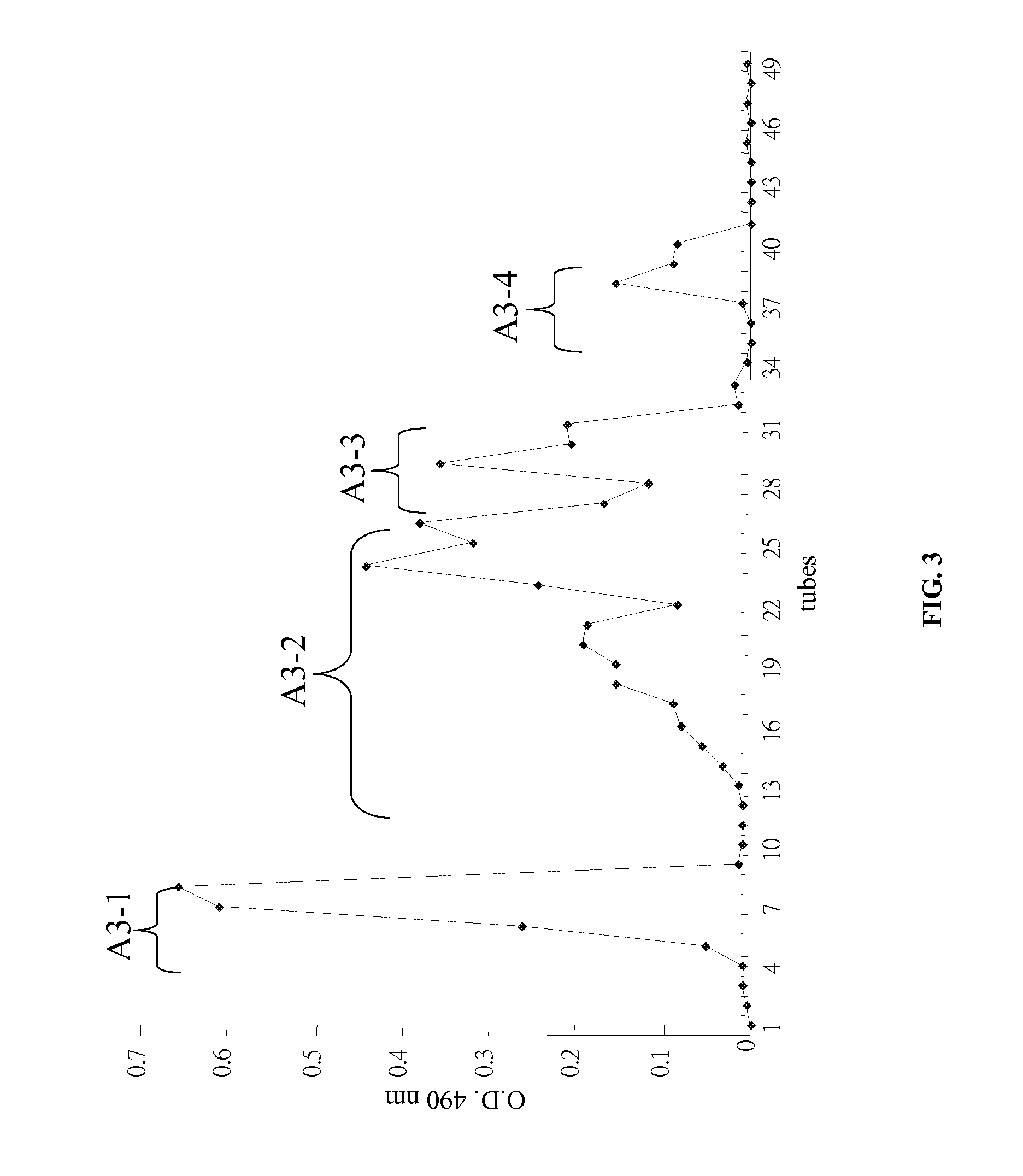Hirsutella sinensis mycelia compositions and methods for treating sepsis and related inflammatory responses
a technology of compositions and mycelia, which is applied in the field of compositions and methods for treating sepsis and related inflammatory responses, can solve the problems of consumptive depletion of the clotting system, and achieve the effects of reducing sepsis mortality, reducing sepsis mortality, and easing symptoms
- Summary
- Abstract
- Description
- Claims
- Application Information
AI Technical Summary
Benefits of technology
Problems solved by technology
Method used
Image
Examples
example 1
[0098]Cell viability was assessed by the MTT (3-(4,S-dimethylthiazol-2-yl)-2,5-diphenyl tetrazolium bromide)) assay based on the reduction of MTT into formazan dye by active mitochondria. Briefly, the cells were placed in 96-well culture dishes at a density of 1×105 cells / ml in DMEM culture medium containing 10% PBS at 37° C., 5% CO2. After attachment overnight, the cells were treated with different concentrations of A3-1 (0, 10, 25, 50, 100, 200 ppm) for 24 h (FIG. 12). Discarded supernatant, MTT solution (1 mg MTT / ml in PBS) was added to each well and incubated for 2 h. After washing, the formazan dye precipitates, the amount of which is proportional to the number of live cells, were dissolved in 100 μL of DMSO. The absorbance was read at 570 nm using a micro-plate reader (Thermo Varioskan Flash). Triplicate wells were analyzed at each concentration. This result shows fraction A3-1 has no cytotoxicity on RAW264.7 cells at doses of 10, 25, 50, 100, or 200 ppm.
example 2
Protective Effects of A3-1 Against Hydrogen Peroxide-mediated Cell Death in RAW264.7 Cells
[0099]The hydrogen peroxide-mediated RAW264.7 cells death is shown in FIG. 13A. The protective role of A3-1 which possesses strong antioxidant activity was tested in the hydrogen peroxide-mediated cell death assay (FIG. 13B). We also measured toxicity of A3-1 indicating that A3-1 is not harmful to RAW 264.7 cells in vitro (FIG. 12) until 200 ppm treatment. RAW264.7 cells were co-treated with hydrogen peroxide (500 μM) and A3.1 for 0, 10, 25, 50 and 100 ppm. The data are presented as mean±S.D. *P<0.05 compared to the group treated with hydrogen peroxide only (n=3), The viability of cells exposed to 500 MTT μM hydrogen peroxide for 24 h with A3-1 co-treatment had more than 60% better survival rate than without A3-1 co-treatment. The data showed that the hydrogen peroxide treatment seriously reduced the viability of cells, and A3-1 had exceptional protective effects on RAW264.7 cells from 50 to 10...
example 3
Quenching H2O2-induced Intracellular ROS of A3-1 in RAW264.7 Cells
[0100]To investigate the mechanism by which A3-1 protects RAW264.7 cells during hydrogen peroxide injury, we analyzed intracellular reactive oxygen species (ROS) levels in RAW264.7 cells with fluorescent spectrometer. Cells were co-treated with 0, 10, 50, 100 ppm A3-1 and with 500 μM H2O2. Attenuation effects of AJ-1 in hydrogen peroxide-induced intracellular ROS in RAW264.7 cells. RAW264. 7 cells were treated with hydrogen peroxide (500 μM) and with 0, 10, 50, 100 ppm A3-1. After 30 min incubation, the cells were loaded with DCFH-DA for 10 min, washed, and measured by fluorescence spectroscopy. (FIG. 14A). Control with H2O2 only, (FIG. 14B). Co-treatment with H2O2 and 10 ppm A3-1, (FIG. 14C). Co-treatment with H2O2 and 50 ppm A3-1 (FIG. 14D). Co-treatment with H2O2 and 100 ppm A3-1. (FIG. 14E). The amount of intracellular ROS was quantified by microfluorometer with excitation and emission wavelengths at 490 nm and 53...
PUM
| Property | Measurement | Unit |
|---|---|---|
| molecular weight | aaaaa | aaaaa |
| temperature | aaaaa | aaaaa |
| time | aaaaa | aaaaa |
Abstract
Description
Claims
Application Information
 Login to View More
Login to View More - R&D
- Intellectual Property
- Life Sciences
- Materials
- Tech Scout
- Unparalleled Data Quality
- Higher Quality Content
- 60% Fewer Hallucinations
Browse by: Latest US Patents, China's latest patents, Technical Efficacy Thesaurus, Application Domain, Technology Topic, Popular Technical Reports.
© 2025 PatSnap. All rights reserved.Legal|Privacy policy|Modern Slavery Act Transparency Statement|Sitemap|About US| Contact US: help@patsnap.com



